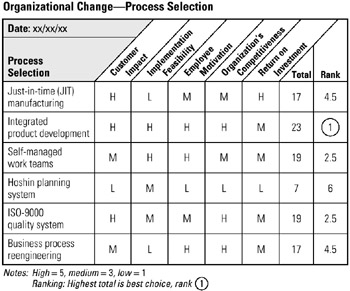Tool 151: Process Selection Matrix
| AKA | N/A |
| Classification | Changing/Implementing (CI) |
Tool description
A process selection matrix uses a set of criteria for prioritization to determine a team's first choice. Typically, the team establishes the criteria and rating method. Team consensus is the basis for completing the matrix.
Typical application
-
To prioritize processes, projects, or systems to be used in a problem-soving or major organizational change effort.
-
To identify a process or tool that promises the greatest return on total investment.
-
To determine ways to improve the organization.
Problem-solving phase
| Select and define problem or opportunity | |
| Identify and analyze causes or potential change | |
| → | Develop and plan possible solutions or change |
| → | Implement and evaluate solution or change |
| Measure and report solution or change results | |
| Recognize and reward team efforts |
Typically used by
| Research/statistics | |
| Creativity/innovation | |
| 3 | Engineering |
| 2 | Project management |
| 4 | Manufacturing |
| Marketing/sales | |
| Administration/documentation | |
| Servicing/support | |
| Customer/quality metrics | |
| 1 | Change management |
before
-
Cost-Benefit Analysis
-
Benchmarking
-
Consensus Decision Making
-
Process Analysis
-
Potential Problem Analysis (PPA)
after
-
Activity Cost Matrix
-
Action Plan
-
Information Needs Analysis
-
Decision Process Flowchart
-
Basili Data Collection Method
Notes and key points
-
If two total scores are tied, add both ranks and divide to assign median to both rank positions. Example: Two scores = 19 for rank position (2) and (3), therefore 2 + 3 =5/2 = 2.5. Rank 2.5 is assigned to both positions, as shown in the example.
Step-by-step procedure
-
STEP 1 The team facilitator prepares a selection matrix and lists all previously determined processes. See example Organizational Change—Process Selection.
-
STEP 2 Participants brainstorm a set of criteria to be used in the rating process.
-
STEP 3 Next, participants rate each process on a scale of high, medium, low using the consensus decision-making technique.
-
STEP 4 The facilitator records each rating and totals all rows.
-
STEP 5 Finally, the process selection matrix is dated and Rank 1 (best choice) is circled.
Example of tool application

EAN: 2147483647
Pages: 326